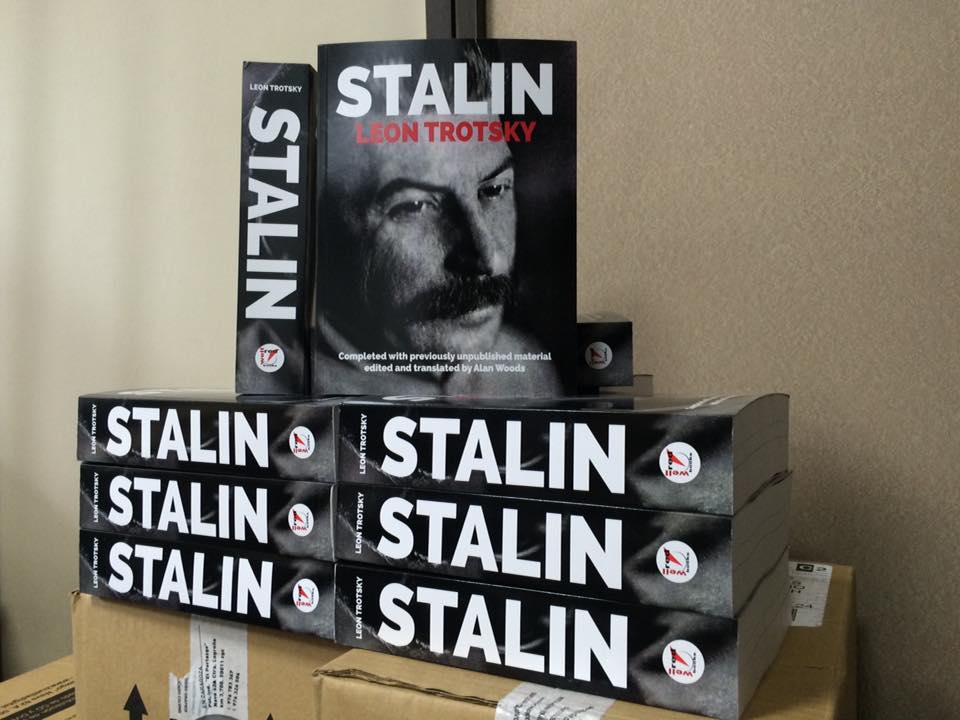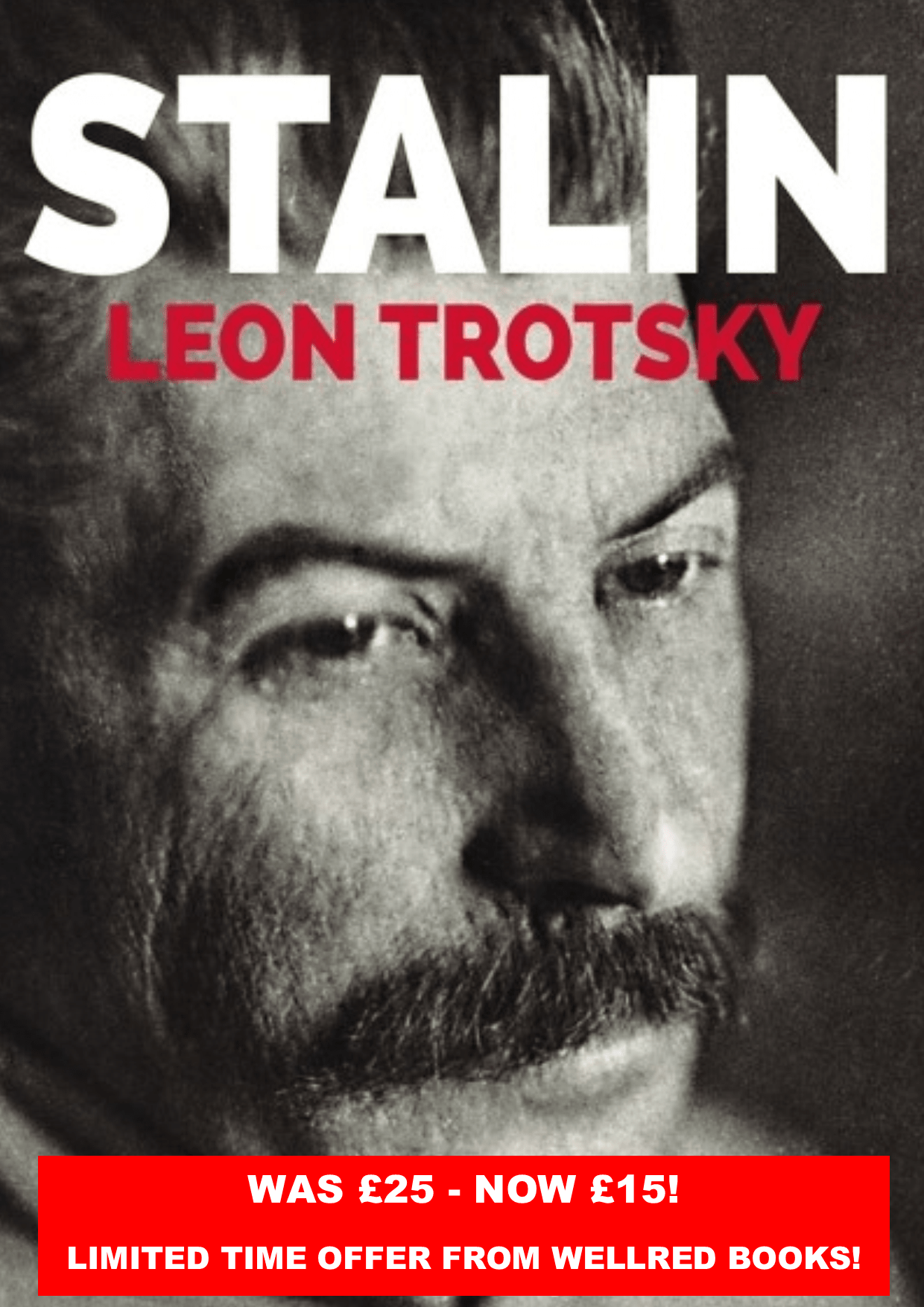Today is the 140th birthday of Ioseb Jughashvili, also known as Koba, but best known as Joseph Stalin: figurehead of the Soviet bureaucracy that seized control of Russia following the degeneration of the Bolshevik regime. We publish here a review (first released on John Riddell's blog) of the new, updated edition of Trotsky's biography of Stalin, originally published in 2016. In his review, John explains how the expanded and revised edition of this biography (edited by Alan Woods) "provides a more satisfactory picture of Stalin’s character" than any previous version. Although we do not agree with all of the ideas presented in the review, we publish it as it would be of interest for our readers.
The new edition of Leon Trotsky’s biography of Joseph Stalin, published in 2016 by Wellred Books, is a significant contribution to our understanding of Trotsky’s thinking in the last years before his assassination in August 1940.[1] This handsome and lavishly illustrated 890-page volume, carefully prepared by Alan Woods and a team of collaborators, presents all the texts collected by Trotsky for his never-completed study, Stalin: An Appraisal of the Man and His Influence. This book also stands as a tribute to Trotsky’s personal courage and historical integrity in pressing ahead with such an ambitious and difficult study even as Stalin mobilized the resources of the Soviet state to kill witnesses, suppress evidence, and unleash his lethal plots to do away with his biographer.
Trotsky’s work consists of two quite different parts.
- The first seven chapters, covering the years up to 1917, were drafted and reviewed by Trotsky as a continuous manuscript.
- The rest of the book consists of fragmentary texts and documents assembled by Trotsky for the remaining chapters that he was unable to complete.
An initial and unauthorized version of this work was published in 1946 by Harper and Bros., translated and edited by Charles Malamuth. [2] It gave rise to both protests and confusion. Malamuth included the chapters on years up to 1917 essentially as prepared in draft form by Trotsky, and this portion is reproduced by Woods with little change. In the second half of the 1946 edition, however, Malamuth selected a portion of Trotsky’s still fragmentary texts and filled them out with extensive bracketed interpolations, which in one chapter made up 62% of the word count.
Trotsky’s cothinkers maintained that Malamuth’s additions ran “direct counter to Trotsky’s own ideas.” Trotsky’s widow, Natalia Sedova, vigorously protested this “unheard-of violence committed by the translator on the author’s rights” – but to no avail.[3]
The objections focused on two concepts in Malamuth’s commentary that contradicted Trotsky’s long-held views. These concepts were: (1) that Stalinism was the inevitable outcome of Bolshevism; and (2) that the Soviet Union under Stalin was no longer in any sense a workers’ state.
In 1946, it was hard to be certain about Trotsky’s intentions on these points, given that much of what he wrote in preparing this volume was not accessible. But Alan Woods’ edition now provides the totality of Trotsky’s writings for this project. The two questions posed back in 1946 can now be revisited.
But before addressing these issues, we will look briefly at the new edition in terms of its stated aim of assessing Stalin as a person and political leader.
Isaac Deutscher’s appraisal
The great Marxist historian Isaac Deutscher included an assessment of the first (Malamuth) edition in volume 3 of his renowned biography of Trotsky. About 50 years ago, I read both books together. Deutscher’s points then seemed to me to be well taken. [4]
Deutscher said that given the way the book was put together, from a mass of diverse fragments, it inevitably lacked the “ripeness and balance of Trotsky’s other works” and included “many tentative statements and overstatements.” Trotsky’s tireless research into all the “nooks and crannies” of Stalin’s life, Deutscher continued, seemed to reveal that the notorious butcher (“Cain”) of the great purges “had been there all the time” even in his schoolboy days.
Among the nooks and crannies in Trotsky’s early chapters are quotations from other writers referring to Stalin’s ethnic heritage: his homeland’s “Asiatic cruelty”; its Georgian people who are “slovenly and shiftless” and “coarse, uncouth.” Deutscher cited this as evidence of Trotsky’s thorough research. To today’s reader, they are offensively orientalist in spirit. [5]
Deutscher regretted the absence of a clear delineation in the portrayal of Stalin’s life between the “potentiality of a criminal act” and its “actuality…. The monster does not form, grow, and emerge – he is there fully formed from the outset.”
All these points ring true. Yet Deutscher concedes that Trotsky would have grappled with these shortcomings had he been able to complete the work. For example, he would doubtless have lingered over the absence of a compelling explanation of why Stalin joined the revolutionary Marxist movement, at a time when it promised so little in the way of influence or rewards.
Stalin’s character and its evolution
Trotsky emphasizes Stalin’s obscurity and unimportance in the Bolshevik party through 1917. Yet scattered through Trotsky’s account are unexplained details that suggest a different picture.
For example, Trotsky stresses that Stalin was relatively unknown in the Bolshevik party going into 1917, yet mentions without comment that Stalin placed third in balloting for the Central Committee at the April 1917 Bolshevik party conference. After that conference, Trotsky tells us, Stalin “practically disappeared from the scene and was hardly ever seen.” Yet in the August CC vote for a now qualitatively expanded Bolshevik leadership (Trotsky and his co-thinkers were now members) Stalin placed seventh. [6]
Such contradictions reflect both Trotsky’s conscientious research and the intervention of Stalin’s assassin in preventing the writer from shaping this raw material into a consistent whole.
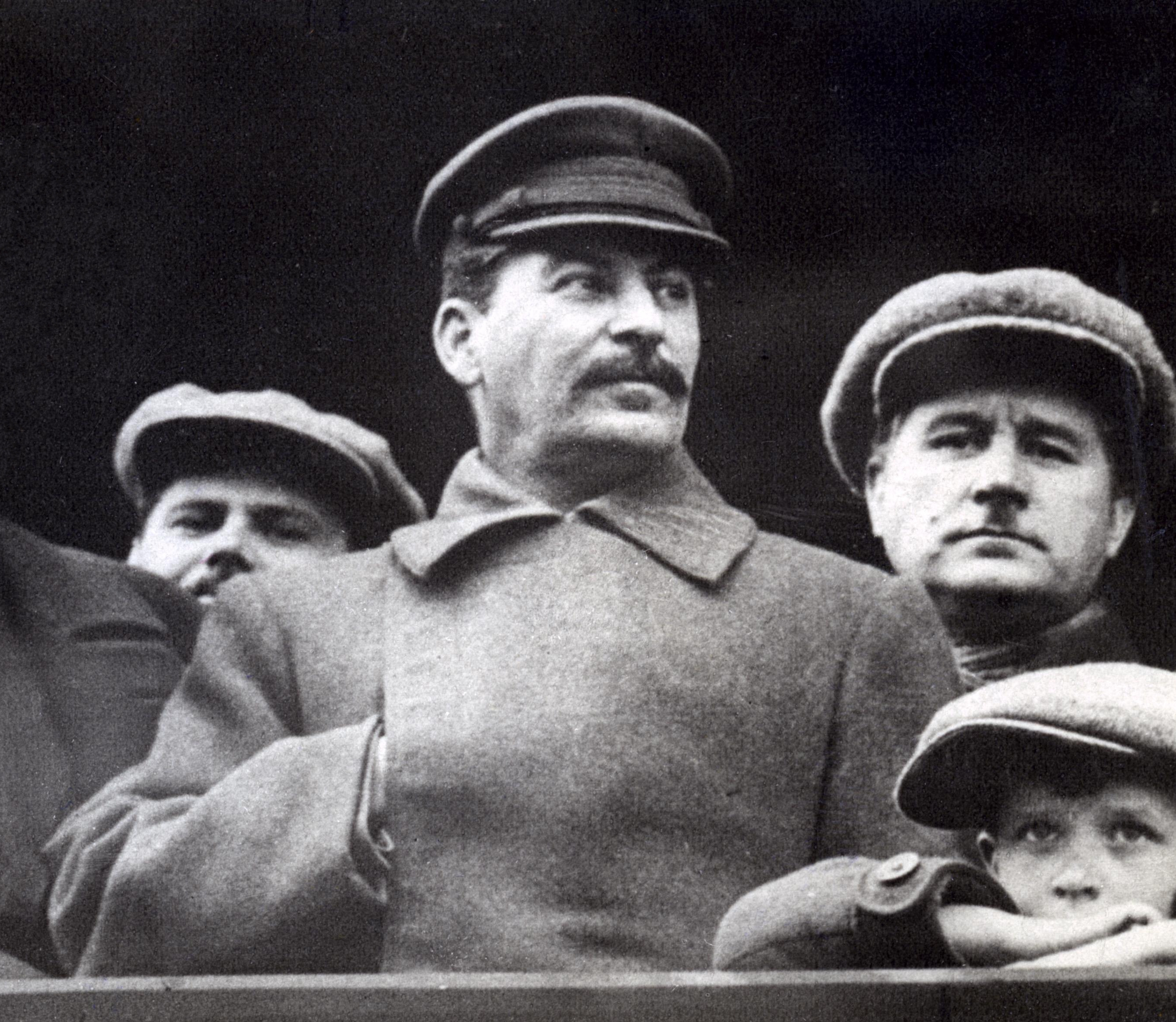 “Stalin began to emerge ... as the organizer, the assigner of tasks, the dispenser of jobs, the trainer and master of the bureaucracy” / Image: public domain
“Stalin began to emerge ... as the organizer, the assigner of tasks, the dispenser of jobs, the trainer and master of the bureaucracy” / Image: public domain
The portrayal of Stalin in the new part of this book, dealing with the period after October 1917, is more gripping and convincing than that of his younger years. Trotsky says that “[t]he revolution then [found] itself in the role of a bankrupt debtor” who has made promises to the working masses that objective circumstance blocks it from fulfilling. This generated social tensions expressed in bureaucratic culture and outlook, vividly and persuasive analyzed in Trotsky’s text.
“Stalin began to emerge .. as the organizer, the assigner of tasks, the dispenser of jobs, the trainer and master of the bureaucracy,” Trotsky says. Growing bureaucratization in the new Soviet state offered scope for Stalin’s “firmness of character and narrowness of outlook,” his single-minded pursuit of power, and, ultimately, his self-seeking cruelty. [7]
Trotsky’s narrative essentially closes in 1928. Stalin’s role in forced collectivization, Soviet industrialization, and the great frame-up purges are mentioned only briefly.
All in all, this new edition of Trotsky’s biographical manuscript, taken as a whole, provides a more satisfactory picture of Stalin’s character than the text available to Deutscher.
Did Bolshevism lead to Stalinism?
It has often been claimed that the structure and methods of Bolshevism before 1917 provided the seedbed for the subsequent development of Stalinism.
Trotsky’s argument in the first half of the book provides some grounds for this speculation. Stalin before 1917 was a “committeeman” par excellence, Trotsky says, a praktik, a political empiricist, who “reacted with indifference and subsequently with contempt toward the émigrés,” that is, toward the “foreign centre” made up of Lenin and his close comrades in exile.
Trotsky also returns in these chapters to his well-known 1904 critique of Lenin and Bolshevism, Our Political Tasks. This pamphlet was “fairly accurate” in stating that “the [Bolshevik] committeemen of those days had ‘foregone the need to rely upon the workers after they had found support in the principle of centralism.’”
Trotsky’s opinion here should be set against Lars Lih’s widely respected analysis of the 1904 debate among Russian socialists in Lenin Rediscovered, which challenges the accuracy of Trotsky’s 1904 observations. [8]
Pointing to Lenin’s statement in 1905 that “there is evidently an illness in the Party,” Trotsky then comments: “That illness was the high-handedness of the political machine, the beginning of bureaucracy.” One might infer that such a bureaucracy, the very essence and breeding grounds of Stalinism, was already a malignant disease in the Bolshevism of 1904. [9]
Yet in reading Trotsky’s words, the context must be kept in mind. The Bolshevik local leaders under tsarism – the “praktiki” — were not office-proud privileged officials. They were activists on the run from severe, unrelenting repression. Trotsky tells us that they spent half their time on average in police detention. Extreme caution in consulting and selecting colleagues was a necessity of “konspiratsiia” – the rules for survival in the revolutionary underground.
The rise of mass workers’ struggles in 1905 eased the pressure of illegality and permitted the party to function more democratically and inclusively. Lenin was among the first to see this and pressed strongly for change. And the party did change, only to endure a new onslaught of tsarist repression in 1907 and after.
Elsewhere in his biography, Trotsky states that the political machine of the Bolshevik Party prior to 1917 was “petty bourgeois in its origins and conditions of life” and that Stalin “expressed the conservative inclinations of the party machine.” In Trotsky’s view, during the weeks after Russia’s February 1917 revolution, the conciliationist drift of this apparatus was steering the party toward liquidation into the Mensheviks. The party was then redeemed only by the arrival of Lenin, whom Trotsky terms “the leader of genius.” [10]
Yet four hundred pages later on, in the second part of Trotsky’s biography, we find a more worked out and polished section entitled “Stalinism vs. Leninism” that repeats general remarks about the deficiencies of the Bolshevik apparatus but comes to a quite different conclusion. Trotsky here repudiates his 1904 pamphlet and affirms that the Bolsheviks achieved a fruitful balance of democracy and centralism. [11] He then explains how outside forces (imperialist blockade and invasion, civil war, economic disruption, extreme deprivation) disrupted this balance:
The violation of this balance was not a logical result of Lenin’s organizational principles, but the political consequence of the changed balance of forces between the Party and the class. The Party degenerated socially, becoming the organization of the bureaucracy. Exaggerated centralism became a necessary means of self-defence.
Revolutionary centralism was transformed into bureaucratic centralism. The apparatus, which cannot and dare not appeal to the masses in order to restore internal conflicts, is compelled to seek a higher power, standing above itself. That is why bureaucratic centralism inevitably leads to personal dictatorship. [12]
Here we have Trotsky’s balanced view, consistent with his other later writings. The overriding cause of Stalinist degeneration was not inherent flaws in Bolshevism, he tells us, but the pressure of objective circumstances.
The discrepancy between these two passages justifies a warning. There are many such false starts and repetitions in the manuscript. If Trotsky had been afforded an opportunity to complete the text and edit it for publication, he would surely have addressed these issues. Stalin’s assassin cut that short. What Trotsky left to us was not a finished book but an archive of materials for a work in progress. As a result, no passage in the manuscript can be taken, in itself, as his definitive opinion.
Bureaucratism from the start?
What are we to make of Trotsky’s criticism of the Bolshevik underground leadership as petty-bourgeois in class orientation, bureaucratic in methods, and conservative in political direction?
First of all, this assertion, found in some pages of Trotsky’s unfinished Trotsky manuscript, contradicts the conviction that guided all his activity after the break with Stalin – that he was defending the historic record and policies of the Bolshevik movement since its inception.
Second, Trotsky is describing the Bolshevik movement during years in which he was in exile and was in strong opposition to their policies. It was not easy for him, in this position, to get a close feel for the Bolshevik movement, and he provides little source material on this point. His opinions carry weight but cannot be convincing without supporting evidence.
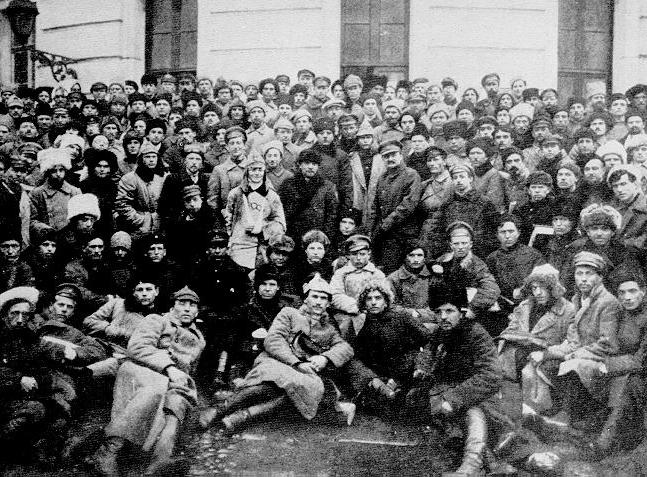 "The overriding cause of Stalinist degeneration was not inherent flaws in Bolshevism [Trotsky says] ... but the pressure of objective circumstances" / Image: public domain
"The overriding cause of Stalinist degeneration was not inherent flaws in Bolshevism [Trotsky says] ... but the pressure of objective circumstances" / Image: public domain
Third, the Bolsheviks’ emphasis on building strong local organizations led by a team of full-time organizers (praktiki) was their distinctive strength among Russian Social-Democratic currents – which Trotsky after 1917 recommended to socialists around the world. If the structure was so deformed, why did Lenin never notice this fact?
The most often-heard answer to this objection is that Lenin transformed the Bolshevik party immediately on his return to Russia in April 1917, a process frequently called the “re-arming of the party.” This interpretation is well stated, for example, in Alexander Rabinowitch’s authoritative history of the revolution in Petrograd. [13] It has been strongly contested by Lars Lih and recently by Eric Blanc; their key writings are on my website, along with rebuttals. These resources provide a basis for informed reconsideration of the “re-arming thesis” and need to be encompassed in weighing Trotsky’s assertions. [14]
Finally, on the face of it, this view seems simply implausible. As Trotsky writes elsewhere in this manuscript, in quite a different context, how is it possible that such a fatally flawed party carried out the October revolution?
Did Trotsky retreat from viewing USSR as a workers’ state?
The new edition of Trotsky’s biography of Stalin, edited by Alan Woods, enables us to test a second hypothesis suggested by the 1946 Malamuth edition of this book: that Trotsky, in his final months, was retreating from his long-held contention that the Soviet Union, even under Stalin’s totalitarian dictatorship, remained a workers’ state.[15]
My own conclusion, having read Trotsky’s text as a whole, is that his comments on the Soviet Union and its ruling layer are consistent with his previous position, particularly regarding its character as a “bureaucratic caste” rather than a new “ruling class.” I see no shift in approach. But my opinion is hardly conclusive, and we must try other lines of inquiry.
My friend and colleague Paul Kellogg has made the helpful suggestion that we examine Trotsky’s use in this manuscript of the concept that the Soviet ruling layer had control over disposition of the social surplus in the Soviet Union. Some have suggested that this control is a defining characteristic of a ruling class. Moreover, identifying the ruling layer under Stalin as a “class” is usually taken to signify, as Trotsky was well aware, of the theory that the Soviet Union under Stalin no longer represented a workers’ state – a theory to which Trotsky always objected.
I found three passages in the book that take up control of the social surplus. In each case the context is the early and mid-1920s, the time of the early New Economic Policy. In each case Trotsky explicitly counterposes control of the surplus by the bureaucracy to that by the newly resurgent capitalist forces. Here are the passages:
- The kulak [rich peasant] joined forces with the small industrialist to work for the complete restoration of capitalism. In this way an irreconcilable struggle opened up over the division of the surplus product of labour. Who would dispose of it in the near future: the new bourgeoisie or the Soviet bureaucracy? (p. 563)
- The economy revived. A small surplus appeared. Naturally it was concentrated in the cities and at the disposal of the ruling strata. (p. 589)
- In regard to the [struggle over the] national surplus product, the bureaucracy and the petty-bourgeoisie quickly changed from an alliance to direct enemies. The control of the surplus product opened the bureaucracy’s road to power. (p. 595)
None of this suggests a recognition that capitalist rule had been restored. That is no surprise; Trotsky then spoke as one of the central leaders of the Soviet state. He then considered that the Soviet government (the “bureaucracy”) acted as an agent of the working class and served its interests. Nowhere in his writings of the time does Trotsky suggest that the Soviet republic was anything other than a workers’ state.
Trotsky expressed this view forcefully. For example, at the Communist International’s Fourth World Congress in 1922, Trotsky defended Soviet economic measures (the “New Economic Policy” or NEP) at length against criticisms expressed by some Communist currents both in Soviet Russia and internationally. He viewed the NEP as a system of measures to strengthen the workers’ state and workers’ power. In the same discussion, Lenin applies the label “state capitalist,” but in a positive sense, with reference to the Soviet economy rather than to its state. Trotsky declined to use that term. [16]
Surely, if Trotsky had concluded, in his final years, that a new ruling class had overturned the workers’ state in the early 1920s, he would have expressed this view openly in his Stalin manuscript and elsewhere.
Date of composition
A second line of inquiry concerns the date of composition. Does this manuscript in fact contain Trotsky’s final comments on the Soviet state under Stalin?
The editors’ introductory material provides clues as to this date. Trotsky continued to write and edit until he was killed on August 21, 1940. But at the time of his death, he is said to have been looking forward to resuming work on “my poor book” after a long and frustrating pause. The latest time that he might have worked on it, we learn, was May 1940. But a review of political events at that time indicates that he must have ceased work at least eight months earlier. [17]
During the last year of Trotsky’s life, a series of events related to the outbreak of World War 2 challenged all Marxists, including Trotsky, to review their analysis of the Soviet Union. These events included:
- The Stalin-Hitler treaty, which gave the Nazis the green light for war.
- The Soviet seizure of the country’s eastern marches of Poland during Hitler’s conquest of that country.
- The structural assimilation of these regions to the Soviet Union, which included not only transformation of the economy but extensive arrests and killings of those judged to be potentially disloyal – an extension of Stalin’s massacres in the Soviet Union during the previous decade. [18]
- Soviet occupation of Estonia, Latvia, and Lithuania and their incorporation into the Soviet Union.
- A Soviet war with Finland.
Some Marxists, including prominent leaders of the Trotskyist movement, took these events as proof that the Soviet Union was no longer in any sense a workers’ state and should not be defended in the onrushing war. In Trotsky’s opinion, although some of these actions could be justified in terms of defending the USSR against German attack, their cost in terms of world workers’ sympathy with the Soviet Union outweighed any military advantage. However, he denied that these developments justified a change in Marxists’ assessments of the Soviet Union.
Trotsky posed Soviet occupation of these borderlands as a test of the Soviet state’s character. Would it be able to tolerate and utilize the capitalist social system in these territories, as – to use a contemporary example – China has done in Hong Kong? On the contrary, capitalist relations were overturned in these regions and the nationalized and planned economy extended to the occupied borderlands, demonstrating the two social systems’ incompatibility.
A debate on these issues flared up among Trotsky’s supporters in the Socialist Workers Party (U.S.), in which Trotsky took an active part. His contributions, running from 12 September 1939 to 17 August 1940, are collected in the book, In Defense of Marxism. [19]
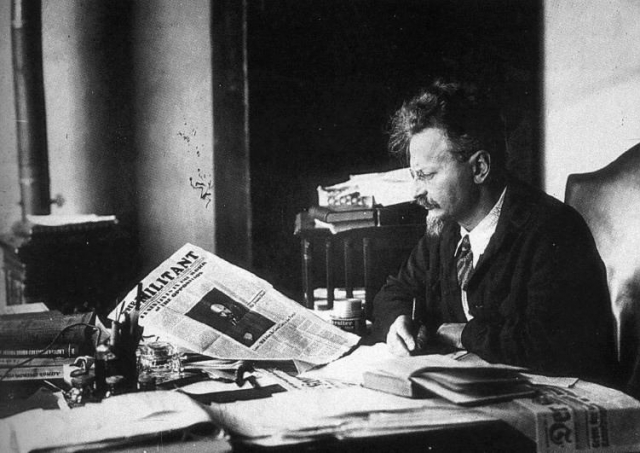 "Some Marxists [argued that the Hitler-Stalin pact, among other factors meant] that the Soviet Union was no longer in any sense a workers’ state and should not be defended in the onrushing war. In Trotsky’s opinion, although some of these actions could be justified in terms of defending the USSR against German attack, their cost in terms of world workers’ sympathy with the Soviet Union outweighed any military advantage" / Image: public domain
"Some Marxists [argued that the Hitler-Stalin pact, among other factors meant] that the Soviet Union was no longer in any sense a workers’ state and should not be defended in the onrushing war. In Trotsky’s opinion, although some of these actions could be justified in terms of defending the USSR against German attack, their cost in terms of world workers’ sympathy with the Soviet Union outweighed any military advantage" / Image: public domain
There is no reference to events of this period or to the discussion around them in Trotsky’s Stalin manuscript.
Could it be that he had just not got to that point in his story? No, quite the contrary, because Trotsky did not write the manuscript sequentially from beginning to end. He assembled materials for all projected chapters simultaneously, and his fragmentary texts and source material were sorted, as they became available, into folders relating to each chapter. If Trotsky had been working on his Stalin biography between September 1939 and May 1940, while he was immersed in writing on the war and the USSR, this would be reflected in his Stalin biography manuscript. The fragments he wrote on the Soviet state’s degeneration, which deal with events as late as 1938, cover 40 pages of the biography. Yet there is no mention in any part of his Stalin manuscript of events after 1938, such as those surrounding the outbreak of World War 2 or of the resulting debate.
This absence makes clear that the manuscript was compiled before the outbreak of war and does not represent Trotsky’s final views on the character of the Soviet Union. These are found in his writings of 1939-40 on the Soviet Union and the war, collected in In Defense of Marxism.
The Soviet Union at war
The Stalin-Hitler pact of 23 August 1939 resulted in immediate calls within the Trotskyist movement for a change of stance regarding the USSR. Trotsky responded to this challenge on 12 September: “Who says that the USSR is no more a degenerate workers’ state, but a new social formation, should clearly say what he adds to our political conclusions.” [20]
The central political issue, as he saw it, was not what to call the Soviet Union but where to stand on its conflicts with imperialist states. “Suppose that Hitler turns his weapons against the east,” Trotsky wrote later that month. The Fourth International, made up of Trotsky’s supporters worldwide, will adopt “as the most urgent task of the hour, the military resistance against Hitler…. While arms in hand they deal blows to Hitler, [they] will at the same time conduct revolutionary propaganda against Stalin preparing his overthrow at the next and perhaps very near stage.” [21]
On 25 April 1940, after more than six months of debate, Trotsky wrote a summary comment in which he called on socialists to “explain to the world working class that no matter what crimes Stalin may be guilty of we cannot permit world imperialism to crush the Soviet Union, reestablish capitalism and convert the land of the October Revolution into a colony.” [22]
A month later, on May 28, he completed a manifesto on the war. It includes a section “Defense of the USSR” that states, in part:
[T]he crimes of the Kremlin oligarchy do not strike off the agenda the question of the existence of the USSR. Its defeat in the world war would signify not merely the overthrow of the totalitarian bureaucracy but the liquidation of the new forms of property, the collapse of the first experiment in planned economy, and the transformation of the entire country into a colony; that is, the handing over to imperialism of colossal natural resources which would give it a respite until the third world war. Neither the peoples of the USSR nor the world working class as a whole care for such an outcome. [23]
Most of the participants in the 1939-40 debate who held that the workers’ state had been entirely extirpated under Stalin embraced a “third camp” position of neutrality regarding conflicts between the USSR and Hitler’s Germany. This position was maintained after Hitler’s forces invaded the USSR the following year. “Third camp” proponents expected the fall of the Stalin regime and the rise of an independent working-class anti-fascist movement. [24]
But events took a different course. When the Nazis invaded, despite some initial uncertainty, working people in the USSR rallied to the Red Army as the only available shield against Nazi genocide. In several years of savage conflict, the Soviet Red Army and the resistance movement across Europe dealt the decisive blows that destroyed Hitlerism.
Was this battle worth fighting? The question has been reposed in Europe today by the rise of far-right movements in many countries – Ukraine, Hungary, France, etc. – whose historical lineage goes back to Hitler’s allies in the Nazi-dominated countries of Europe.
For many neo-Nazis in Europe today, Hitler’s war against the U.S. may seem misguided, but his crusade in Eastern Europe was a just war against communist barbarism. Socialists must do better than merely take a stance of neutrality.
Reference to the horrendous human cost of Stalinist repression do not help us here. Trotsky affirmed that the Stalinist system of rule was similar to that of Hitler, applying the epithet “totalitarian.” But the question posed by the Nazi invasion was whether working people could make use of the Soviet state and army to resist and defeat fascism and, thereby, open the road to revolutionary gains.
A war of colonial conquest
In this regard, it is significant that both the quoted statements by Trotsky in the last months of his life on defense of the USSR note that the goal of Hitlerite Germany in its impending war against the Soviet Union would be not merely to conquer it and lay claim to its resources but to subject it to a vast project of settler colonialism. This was no secret at the time. Germany’s rulers had floated this project many decades previously, terming it the quest for “Lebensraum” – living space. In 1914, they had integrated it into their war aims. The Nazis picked up on this project, included it in their foundational statements, and imbued it with their characteristically aggressive racist extremism.
The German attack on the USSR had the explicit goal of killing thirty million Soviet citizens through starvation in order to free up food for the needs of the Nazi empire. This and other dimensions of Nazi genocidal plan were implemented from the start of their invasion. [25]
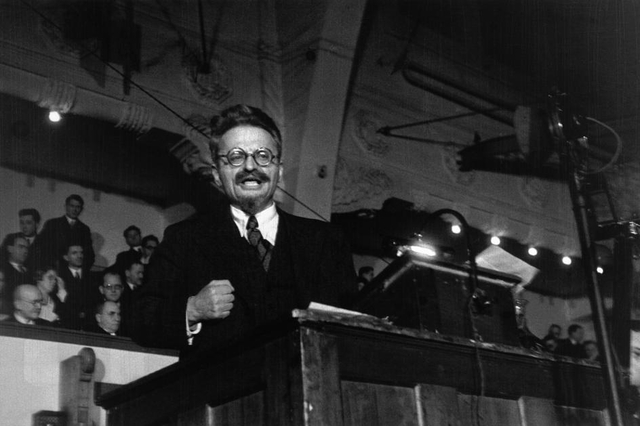 "[I]n spite of monstrous bureaucratic distortions, the class basis of the USSR remains proletarian ... the bureaucracy has not yet ventured to resort to the restoration of the private ownership of the means of production. But let us bear in mind that the unwinding process has not yet been completed and the future of Europe and the world during the next few decades has not yet been decided" / Image: public domain
"[I]n spite of monstrous bureaucratic distortions, the class basis of the USSR remains proletarian ... the bureaucracy has not yet ventured to resort to the restoration of the private ownership of the means of production. But let us bear in mind that the unwinding process has not yet been completed and the future of Europe and the world during the next few decades has not yet been decided" / Image: public domain
During the opening weeks of the invasion, working people of the Soviet Union, realizing the Nazi’s true intentions, rallied to the Red Army as the only available instrument with which they could resist and defeat Fascism.
As Marxist theorist Ernest Mandel later pointed out, the Nazis’ genocidal methods were not new: they had been used before against peoples of Asia, Africa, and America. What was particularly horrifying about Nazi genocide was its employment against industrialized and culturally “advanced” white peoples of Europe. [26]
It is here, in the resistance to Hitler’s anti-Soviet war, and not in references to control of the social surplus, that we find the core of Trotsky’s final judgment of the Soviet Union.
This neglected anticolonial thread in Trotsky’s final statements on defense of the Soviet Union provides a framework within which Marxists who differ on sociological definition of the Soviet Union can find common ground in their assessment of the historic clash of German fascism with the Soviet Union.
The last word
Trotsky’s text as presented in Alan Woods’ edition ends with a prophetic reiteration of the author’s verdict on the Soviet Union under Stalin:
“[I]n spite of monstrous bureaucratic distortions, the class basis of the USSR remains proletarian. Although it undermines these achievements, the bureaucracy has not yet ventured to resort to the restoration of the private ownership of the means of production. But let us bear in mind that the unwinding process has not yet been completed and the future of Europe and the world during the next few decades has not yet been decided.” [27]
Notes
[1]. Leon Trotsky, Stalin: An Appraisal of the Man and His Influence [Stalin], translated and edited by Alan Woods, London: Wellred Books, 2016. The introduction by co-editor Rob Sewall is available online. Photographs are taken from the collection of the late David King.
[2]. Leon Trotsky, Stalin – an Appraisal of the Man and his Influence, translated and edited by Charles Malamuth, New York: Harper & Bros., 1946.
[3]. See John G. Wright, “A Biography of Stalin,” Fourth International, July 1946, pp. 18–21, and Rob Sewell’s introduction to the 2016 edition.
[4]. Isaac Deutscher, The Prophet Outcast: Trotsky 1929-1940, London: Oxford University Press, 1963, pp. 451-7.
[5]. Stalin, pp. 8, 9, 10.
[6]. Stalin, pp. 256, 260, 281.
[7]. Stalin, pp. 653, 655, 664
[8]. Lars T. Lih, Lenin Rediscovered: “What Is to Be Done?” In Context, Chicago: Haymarket, 1908.
[9]. Stalin, pp. 82–84.
[10]. Stalin, pp. 257, 265, 259.
[11]. Stalin, pp. 673–7.
[12]. Stalin, p. 676.
[13]. Alexander Rabinowitch, Prelude to Revolution: The Petrograd Bolsheviks and the July 1917 Uprising, Bloomington: Indiana University Press, 1991, pp. 32–47.
[14]. See in particular:
- Lih, Lars, “All Power to the Soviets,” a series of studies listed at “A Basic Question: Lenin Glosses the April Theses.”
- Blanc, Eric, “A Revolutionary Line of March: ‘Old Bolshevism’ in Early 1917 Re-Examined.”
- Le Blanc, Paul, Re-Arming the Party: Bolsheviks and Socialist Revolution in 1917
- Proyect, Louis, “The Revolutionary Democratic-Dictatorship of the Proletariat and the Peasantry? Say What?”
- Marot, John, “Lenin, Bolshevism, and Social-Democratic political theory.”
[15]. See Leon Trotsky, Stalin: An Appraisal of the Man and His Influence [Stalin], translated and edited by Alan Woods, London: Wellred Books, 2016 and Leon Trotsky, Stalin – an Appraisal of the Man and his Influence, translated and edited by Charles Malamuth, New York: Harper & Bros., 1946.
[16]. See the speeches by Lenin (pp. 292-305), Trotsky (pp. 347-371), and Clara Zetkin (pp. 305-337) on the New Economic Policy which appear in Riddell, ed., Toward the United Front, 2011. The speeches are analyzed, with references, ibid. pp. 36–41.
[17]. Stalin, xxiv-xxix.
[18]. Long after the war, Russian authorities admitted Soviet responsibility for the notorious “Katyn” massacres, in which some 20,000 suspects were killed.
[19]. Trotsky, In Defense of Marxism: The Social and Political Contradictions of the Soviet Union [IDOM], New York: Pathfinder, 1990.
[20]. Trotsky, IDOM, p. 1: “A Letter to James P. Cannon,” September 12, 1939.
[21]. Trotsky, IDOM, p. 20.
[22]. Trotsky, IDOM, “Balance Sheet of the Finnish Events,” p. 176.
[23]. “Manifesto of the Fourth International on Imperialist War and the Proletarian Revolution,” in Writings of Leon Trotsky, 1939-40, New York: Pathfinder, 1973, pp. 183-222. See also Trotsky’s letter on completing the Manifesto, ibid., 228-9.
[24]. See “The War in Russia,” a manifesto of the American Committee for the Fourth International, in New International, September 1941, pp. 241–7.
[25]. Alex J. Kay, “The Radicalization of German Food Policy in Early 1941,” in Kay, Jeff Rutherford, and David Stahel, ed., Nazi Policy on the Eastern Front, 1941, Rochester: University of Rochester, 2012,
[26]. Ernest Mandel, The Meaning of the Second World War, London: Verso, 1986, pp. 90-3. See also Ava Lipatti, “Russophobia and the Logic of Imperialism,” posted by the Hampton Institute on 8 June 2017. Lipatti builds on Domenico Losurdo’s War and Revolution: Rethinking the Twentieth Century, London: Verso, 2015.
[27]. Stalin, p. 690.

